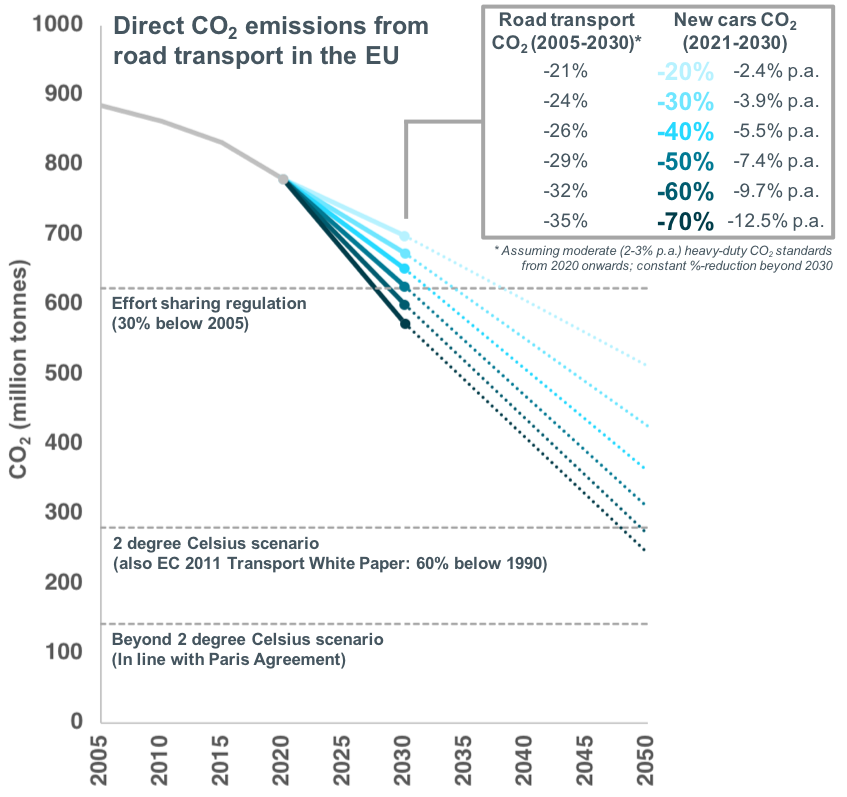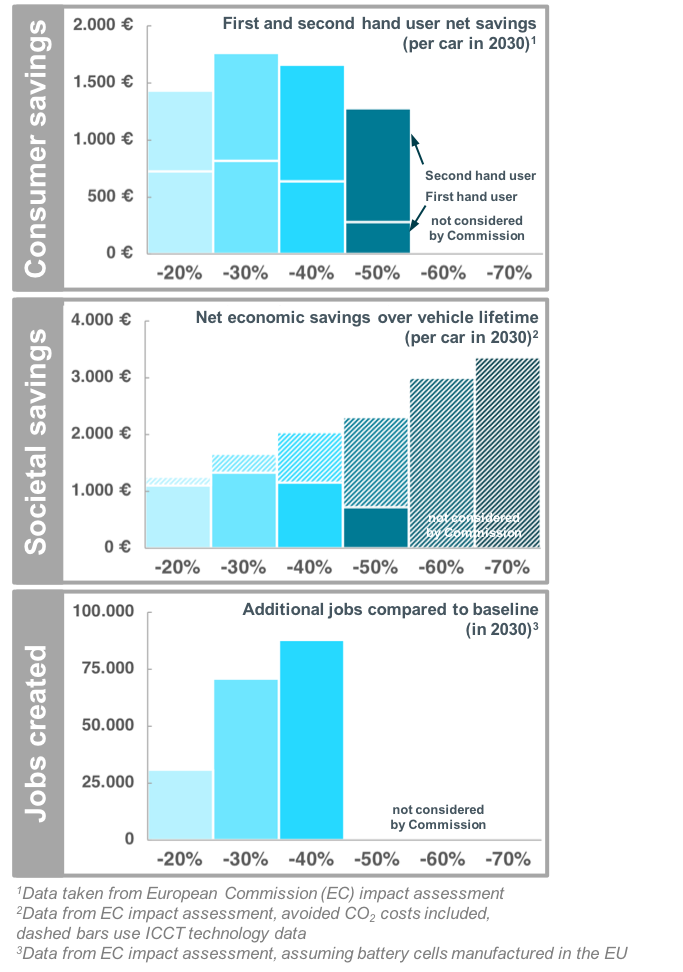Blog
A no-regrets option: What discussions in the European Parliament spotlight about a light-duty 2025–2030 CO2 standard for the EU
Recently I attended a workshop in the European Parliament on CO2 standards for new passenger cars and vans for 2025–2030, organized by the Committee on Environment, Public Health and Food Safety (ENVI). Miriam Dalli, MEP for Malta, who as rapporteur on the legislation is leading negotiations for the Parliament, invited five experts from independent research institutes to present their viewpoints. The presentations, as well as the Q&A session that followed, were recorded and you can watch them here.
What struck me during that workshop was the broad agreement of the panelists on what steps need to be taken and how far, by comparison, the regulatory proposal from the European Commission is from actually taking them. In particular, there was consensus that the average CO2 emission level of new cars and vans needs to drop by at least 60% between 2020 and 2030 in order to be in line with EU climate targets. And that such a strong CO2 reduction would also result in positive effects for consumers, the economy, and society as a whole. Compare that to the proposal of the European Commission, which suggests a reduction of only 30% by 2030.
This spurred me to take another look at the 400+ pages of documents that accompany the Commission’s proposal, to see what light they might shed on the different perspectives.
Consider, first of all, the climate perspective. The chart below illustrates how direct CO2 emissions from the road transport sector in the EU have developed in past years and how they are likely to develop in the period up to 2030. Future emissions depend on the level of ambition of the post-2020 light-duty CO2 regulation, something that is currently under discussion in the European Parliament. I’ve plotted six scenarios, ranging from a 20% reduction to a 70% reduction, all with respect to the average new car emissions from 2021 to 2030 (I assume the same percentage reduction for vans, but for those vehicles the starting year is 2020 – see why here). For heavy-duty vehicles, I assume a moderately ambitious annual CO2 reduction requirement of 2%–3%. We will find out if this assumption is in line with the political plans in early May, when the European Commission is expected to come forward with a proposal for the EU’s first-ever mandatory CO2 standards for heavy-duty vehicles.

The 2 degree and Beyond 2 degree estimates are based on IEA data from Energy Technology Perspectives 2017 © OECD/IEA 2017. Licence: www.iea.org/t&c; as modified by ICCT.
Given these assumptions, we can model how new vehicles will diffuse into the existing vehicle fleet and how overall road transport emissions will change. They will decrease, but more slowly overall than emissions of new vehicles only, because it will take time to replace older vehicles manufactured when the CO2 standard was less stringent. For example, taking the 30% reduction for new cars and vans between 2021 and 2030 proposed by the Commission, CO2 emissions from the road transport sector as a whole would decrease by about 24% by 2030, compared to 2005. This is less than the 30% reduction required on average by the Effort Sharing Regulation (ESR) for sectors not covered by the EU Emissions Trading System (ETS). (Transport is one of the sectors not covered by the ETS.)
The European Commission does not regard the resulting gap as problematic. It assigns the transport sector only an 18%–19% CO2 reduction by 2030, so from the Commission’s perspective the current light-duty CO2 regulatory proposal is fully in line with the ESR requirements. That calculation, however, only works out because the Commission is assuming other sectors will contribute substantially more to CO2 reductions. Specifically, the Commission assumes 29%–35% in the agricultural sector, 35%–37% in the industry sector, and 38%–43% in the buildings sector. But panelists at the Parliament workshop unanimously expressed reservations about whether those targets for other sectors will actually be met. Instead, the consensus was that the road transport sector will have to contribute more CO2 reductions than the average ESR requirement of 30% in order for us to have a chance of reaching the overall target of 30% by 2030.
A more ambitious CO2 standard for new vehicles is also crucial from the perspective of individual EU member states. Take Germany, where the road transport sector will have to reduce CO2 emissions by 40%–42% by 2030 for the country to meet its own targets and its EU-internal commitments as part of the ESR. If vehicle CO2 standards do not contribute sufficiently towards reaching this objective, the German government would have to take additional measures to compensate for the missing tons of CO2 reduced. Such measures could include politically painful actions such as repealing the tax incentives for company cars or introducing a speed limit on German highways (as explained in a recent study by Agora Verkehrswende). And even then, Germany – like many other member states – would still be at risk of missing its ESR target, and as a result facing penalties for non-compliance.
And looking beyond 2030 it becomes even clearer that a higher level of ambition will be required. Assuming that new vehicle CO2 standards would continue to decline at a constant annualized rate, we would need a 10% annual CO2 reduction (which equals a 60% reduction requirement for new cars in 2021–2030) in order to be in line with a 2 degree Celsius scenario. The 4% annual reduction proposed by the European Commission so far would not be sufficient. To be on a pathway to compliance with the Paris Agreement, which aims to limit warming to 1.5 to 2 degrees, we would need even more, as the chart above illustrated.
Coming back to the European Parliament event, there was not only broad consensus that a higher level of ambition on vehicle CO2 emissions is required. There was also widespread agreement that the technology is available to meet more ambitious targets at a net benefit for consumers and society.
A vehicle efficiency standard with ambitious CO2 targets forces manufacturers to equip their new vehicle offerings with more fuel-saving technology than would otherwise be the case. In the process, new jobs are created for workers to develop and manufacture the additional technologies put into new vehicles. Consumers will end up paying more for the vehicle, but they’re also getting a higher value product: because CO2 and fuel consumption are directly linked, consumers will pay much less to fuel their vehicle. Money that would otherwise be spent importing oil from abroad will now be spent within the EU. A portion of those fuel savings will pay for the cost of innovative vehicle technologies; the rest can be spent on other goods and services that result in value-added for the European economy.

As these charts show, the Commission’s own calculations, made for the regulatory impact assessment, indicate that consumer savings on fuel costs will outweigh the necessary investment in new technologies for all scenarios studied. Even if new-vehicle CO2 emissions were required to fall by 50% between 2021 and 2030, a first-hand vehicle owner would still benefit from 282 Euros in net savings during the first five years of ownership and a second-hand owner from an additional 996 Euros in net savings. Unfortunately, the Commission did not run the calculations for a 60% or 70% reduction scenario. For society as a whole, now considering the entire lifetime of new vehicles, the picture is the same. Even for the 50% reduction scenario, the outcome is positive, resulting in a net benefit of 726 Euros per vehicle in 2030, including avoided CO2 costs. And that is when using the rather conservative technology cost assumptions of the Commission. Plugging in ICCT’s estimates instead, the net benefit for society would be much higher and actually increases with more ambitious CO2 reduction requirements. With respect to employment impacts, the most ambitious scenario studied by the Commission (40% CO2 reduction) turns out to also create the highest number of additional jobs, especially if (but not only if) the electric vehicle batteries are manufactured in the EU.
In short, the Commission documents shed considerable light—and they brightly illuminate the conclusion that increasing the ambition of the 2025–2030 CO2 proposal currently on the table would be a no-regrets move for the European Parliament and the EU Member States. Even assuming the addition of heavy-duty vehicle CO2 standards, CO2 targets for new cars and vans will need to be reduced at least 60% from 2021–2030 in order to be in line with a 2 degree Celsius scenario. These standards will also address existing market failures by forcing more innovative technology into new vehicles. At the same time, they will stimulate investments in the auto industry that create jobs and enable European automakers to remain competitive in an increasingly efficient and electrified global car market. First and second vehicle owners will likewise benefit from net operating savings that free up money for other goods and services. So, considering the opportunity to increase the ambition of the 2025–2030 CO2 proposal, the only real regret would be failing to take advantage of it.
